Little boxes on the hillside
Little boxes made of ticky tacky
Little boxes, little boxes
Little boxes all the same.
— Malvina Reynolds, “Little Boxes,” 1962
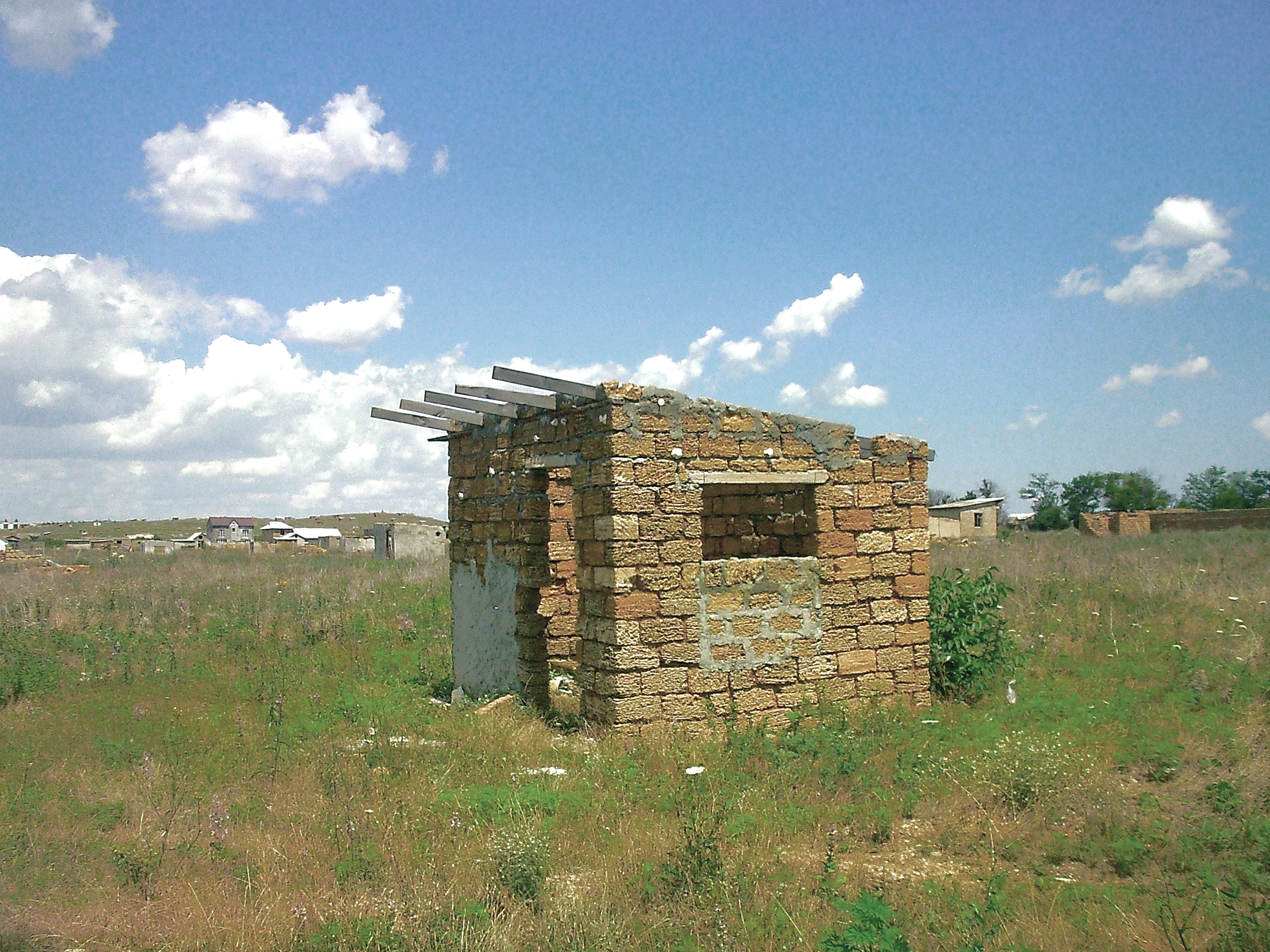
The Hut
Another primitive hut.1 Built with rough limestone blocks and corrugated metal roofing, it measures approximately two by two meters in area. Sometimes it has a door and a window, sometimes just a door. It is solid, heavy, resolutely present—and empty.
I grew up with these huts. Small and rough, they are scattered across the landscape of Crimea, the little peninsula just south of the Ukrainian mainland, now under Russian occupation. They dot grassy fields, hillsides, and shorelines throughout the region, always arranged in rough but consistent grids. You’d see them on your daily commute from the outskirts into the city center, on your way to the beach, on the bus ride to the market. As a child, I didn’t give them much thought. I didn’t question their presence, or the absence their vacancy announced. Part of the spatial logic of the everyday, they faded into the background: commonplace, recursive, a little funny, slightly uncanny, and, in the end, banal.
I’m sure I knew what they were, though I lacked the ability to fully comprehend their meaning. In the absence of human inhabitants, we called them birdhouses, or sometimes, in a less flattering but perhaps more accurate register, outhouses. Elementary and crude at first glance, the hut is anything but. It’s too small to live in, too heavy to be temporary, too makeshift to be permanent, too structured to be accidental. Its somewhat improvised construction reveals a provisional quality, while its serial repetition discloses a logic, a method, a function, all entangled in dense histories of violence, displacement, and land dispossession, most recently through Russia’s annexation of Crimea in 2014 and then its full-scale invasion of Ukraine in 2022. But the hut’s story begins elsewhere.
On May 18, 1944, following Joseph Stalin’s Order No. 5859SS, the entire ethnic Crimean Tatar population, Indigenous to Crimea, was forcibly removed from their homes. They were loaded onto cattle trains and deported to Central Asia and Siberia, with the majority sent to Uzbekistan. While most commonly referred to as “the deportation,” the events of 1944 are now recognized by many as an underacknowledged genocide perpetrated by Soviet authorities.2 Nearly half the deported Crimean Tatars died during or shortly after the forced deportation due to executions, poor sanitation, and lack of food and water on the grueling weeks-long train journey.3 Those who survived were confined to highly regulated special settlement camps in exile, enduring forced labor, poverty, starvation, and disease.
Crimeans4 were prohibited from returning to their homeland until 1989. Attempts to enter the territory resulted in deportation back to Uzbekistan, confinement in labor camps, or imprisonment. When the ban was lifted, Crimeans returned en masse, finding their former homes and farms occupied by new residents: Russian and Ukrainian settlers relocated under Stalin to repopulate the confiscated land.5 Efforts to reclaim property through legal channels—appeals, petitions, and formal requests for compensation—were repeatedly denied or ignored, leaving Crimean Tatars with no path to restitution. They faced systemic discrimination upon their return, including bureaucratic barriers to citizenship, housing, employment, and essential services. With no institutional recourse, Crimeans adopted a strategy of illegally occupying vacant land by building small huts as signifiers of claimed territory.
Squatting is typically a bodily act whose strength lies in the body inhabiting a particular space or enclosure. It’s an assertion of claim through physical occupation. The hut operates through a different kind of logic, one that does not hinge on direct bodily presence; while built as a functional shelter, the hut does not aim to house anyone. The body is absent, its function taken up by the built structure itself. This shift was both tactical and necessary, circumventing the government crackdown on squatting and the immediate vulnerability of eviction, thereby making the claim to the land more durable. Systematically expelled and rendered illegible within official frameworks, the returnees now relied on proxies in their struggle for the right to exist. In other words, their bodily absence was the method by which they could assert their presence.
As the practice became increasingly widespread, these huts quickly entered the vernacular of the local landscape and the squatted lands became known as polyany protesta—protest fields.
The Territory
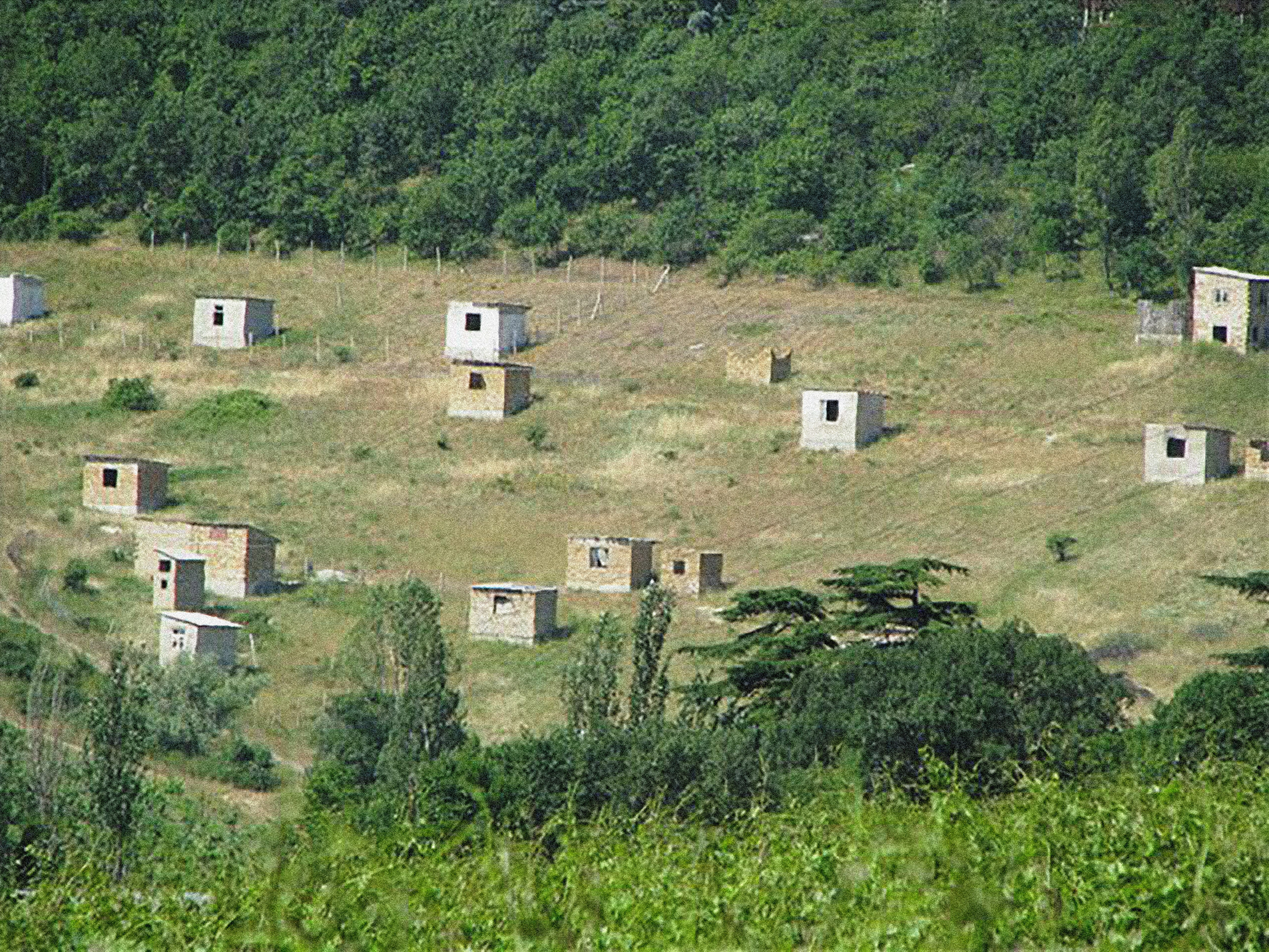
To understand the protest field, however, we must zoom out to the territory at large. The first Russian annexation of Crimea (at the time, the recently independent Crimean Khanate) was authored by Catherine the Great in 1783. Russia needed its paradise.6
Surrounded almost entirely by the Black Sea and the Sea of Azov, the landscape of Crimea is incredibly varied. At its northern point, there is a thin land tie to the Black Soil of Ukraine.7 Inland, the steppe stretches out in a vast, flat, grassy monotone. In the south, hilly vineyards and orchards give way to thickly forested mountain ranges, which in turn drop sharply to a narrow coast.
It is here, on the beach-lined shores, that the Russian royalty found its paradise and set up both its Black Sea navy port and a playground of palaces. The annexation marked the beginning of a systematic campaign to depopulate and Russify the peninsula throughout the eighteenth and nineteenth centuries. This campaign included mass executions and expulsions of Crimeans, and a relentless dismantling of religious and social structures that had long governed Crimean Tatar society. Crimeans, a Sunni Muslim ethnic group, were targeted through the destruction and conversion of mosques and Islamic monuments, as well as broader suppression of Islamic institutions.8 The first mass deportations of Crimeans took place as early as 1784, followed by successive waves throughout the nineteenth century.9 Simultaneously, mass resettlement of ethnic Russian and Russified populations cemented Russia’s demographic dominance, drastically reshaping the region’s cultural landscape. These policies were aimed at permanently eradicating Indigenous presence. They were not simply about the control of an isolated territory; rather, they were part of a broader imperial strategy that sought to redefine Russian politics, culture, and identity on a global scale.10 This era of conquest saw the Russian state expand dramatically, positioning itself as a major force on the European continent in an effort to emulate Western European empires.11
For the remaining Crimeans, this process catalyzed a profound shift in how they conceptualized their relationship to the land. A coherent Crimean identity was formulated only and precisely in response to the foreign occupation: “prior to the late 18th Century, there had been no well-articulated political theory among the Crimean Tatars which proclaimed their unique claim to, and identification with a particular [land] unit as a national homeland.”12 Crimeans—previously oriented toward the Ottoman Empire as their spiritual and political center—had historically tied their identity more closely to the world of Islam than to a fixed geographical territory. The notion of vatan (homeland, related to the Arabic watan), as a territorially bound national identity, was a relatively new idea, introduced through European influences in the late eighteenth century.13 As Bernard Lewis notes in an article about the watan, the term historically referred to one’s place of residence, “which may be adopted or temporary,” rather than anything “paternal or ancestral.” The word evolved following its usage in descriptions of European events, eventually shifting its meaning in public consciousness. Reinforced through Russian education and influence, this evolving notion of homeland took root in younger generations of Crimean Tatars. Regional and dialectical differences among Tatar communities within Crimea were gradually subsumed by a new framework—the land-bound nation-state—that insists on the inseparability of people and place, a logic in which “only the wedding of sap, blood, and soil can be considered a real bond.”14
As Russian imperial policies sought to erase Crimean Tatar presence through displacement and resettlement, the very experience of dispossession reinforced a new kind of national consciousness—one that linked identity to land in a way that had previously been more fluid. The result is a paradox: an unintended population, a people whose sense of nationhood was in part manufactured by the very forces that sought to erase it.
By the late nineteenth century, the transformation to a political notion of homeland became explicit. The Crimean Tatar national movement, emerging in response to colonial subjugation, made clear that the Crimean Tatars were not a dispersed people but an occupied nation. As one historian notes, “If this colonial situation was not immediately recognizable for what it was, the beginnings of the Tatar national movement during the late nineteenth century made it apparent.”15 In the early twentieth century, the Young Tatars, a nationalist-revolutionary movement composed of Crimean intellectuals, sought to define Crimea as their vatan—a homeland to which they had “unalienable historical rights.”16 Influenced by and allied with Russian revolutionaries, they worked to construct a national consciousness that would not only resist Russian colonial rule but also assert Crimean Tatars as a political entity in their own right. They also aligned themselves with Ukrainian revolutionary anti-imperial movements, forging connections with broader anti-colonial struggles. At the same time, while firmly emphasizing a distinct, territorially defined Crimean identity, the Young Tatars maintained broader Turkic and Islamic allegiances. Operating via underground networks, they organized educational and social programs, advocated for educational reform, and ran a prolific press. Among their many publication ventures, the newspaper Vatan Hâdimi was central to their movement.17 Its rhetoric was radical: calling for land redistribution, national rights, and resistance against Russian colonial rule. It also became a key platform for a generation of “poets and authors, many of whom would become the celebrated Crimean Tatar literary figures of the first half of the 20th Century.”18
The homeland identification process continued throughout the collapse of the Russian Empire and the rise of the Soviet Union: early Bolshevik policies initially encouraged the development of Crimean Tatar culture, supporting dance, theater, literature, and local-language education. This was part of the broader Soviet policy of indigenization, which sought to promote Indigenous nation-building as a means of advancing socialism while also containing nationalist movements. At first seen as a politically necessary strategy, with Lenin’s death and Stalin’s rise to power the policy’s effects became a threat.19 State repression began in the 1920s and escalated throughout the 1930s.20 Stalin’s 1944 deportation brought the cycle full circle, “by closing the anti-imperial project to return the Crimea to the imperial situation in its most radical version: the complete eradication of the native.”21
Cleared of Indigenous presence, Crimea became “central to the Soviet production of paradise,”22 as it had been to Russian royals roughly a century and a half before. Soviet-built health resorts, vacation homes, and summer camps supplemented Tsarist palaces, making Crimea “a cherished summer vacation destination in the Soviet Union, as few Soviets were allowed to travel abroad.”23 In exile, Crimean Tatars were supposed to vanish: the deportation and subsequent Soviet policy were designed to displace them so thoroughly that they would dissolve into the Soviet hinterlands, absorbed into some other state’s statistics. “Nearly half of the deported Crimean Tatars died,” the record tells us.24 For surviving Crimeans, their homeland remained a paradise lost. In their places of exile, they were stripped of their basic cultural and ethnic rights and denied equal citizenship status.25 They fought for their return. They mobilized as a national movement in exile—a remarkable case of anti-colonial resistance—advocating for their right to return through protests, hunger strikes, petitions, and organized letter-writing campaigns. A 1967 Soviet decree purportedly restored their rights, but the reality was different. As Mustafa Dzhemilev recalled in an interview, “thousands of Crimean Tatars returned to their homeland, but they were expelled once again.”26
It wasn’t until the late 1980s, amid Mikhail Gorbachev’s reforms and the broader unraveling of the Soviet Union, that their fight gained traction.27 Crimean Tatars led a historic sit-in in Moscow’s Red Square,28 becoming the first ethnic group in the crumbling Soviet empire to demand justice so publicly.29 Between 1987 and 1989, they returned in the thousands, but the collapse of the USSR in 1991 transformed their struggle from an internal Soviet matter into a geopolitical fault line. Crimea was now in limbo. Though Ukraine declared independence in 1991 and included Crimea within its borders, the region’s political status remained volatile. Many in Crimea, particularly ethnic Russians who had settled there after the deportation, viewed Ukraine’s independence with skepticism—or outright opposition.
For the returning Crimeans, Ukrainian independence presented both an opportunity and a new set of obstacles: Kyiv’s official support for their repatriation was undermined by local resistance in Crimea, where Russian nationalist sentiment ran high. The local government, dominated by Soviet-era elites, stoked fears of ethnic conflict and Islamic fundamentalism to justify policies that excluded Crimeans from full citizenship. Authorities refused to grant Crimeans residence permits, denied them legal land ownership, and actively worked to prevent the establishment of Crimean settlements.30 As state-owned property was privatized, newly emerging local elites—backed by commercial and political networks—seized valuable coastal land along the Black Sea for their own gain. They formed shifting land alliances, manipulating an opaque and corrupt system of land redistribution to ensure that the land was allocated primarily to ethnic Russians.31
In this landscape, Crimean protests and claims to land were met with fierce opposition. “We were told there was no available land—this one belonged to collective farms, that one to the state, another was reserved for something else. That was when the process of land seizures began.”32 Call it what the state calls it: samozahvat (self-seizure). Call it what we call it: samovozvrat (self-return). It began as temporary tents, improvised shelters, wire-marked perimeters, protest banners, police clashes, and Molotov cocktails.33 Over time, the movement grew: “People began building small temporary buildings and demanding that local authorities legalize these lands by allocating them for new residential districts.”34 It evolved into makeshift communities—there were communal kitchens, first aid posts, vegetable crops, and places for worship. Families lived in these fields, sometimes five or more in a single hut. Protests spread from the outskirts of cities to the steps of the Supreme Council of Crimea and other government buildings. Delegations went to Kyiv. The “land issue” became impossible to ignore, covered extensively by local and national media.35 And for a while, it worked: by 1990, Crimean Tatars were finally issued building permits. By 1995, at least 1,000 squatted land plots had been (re)claimed.36
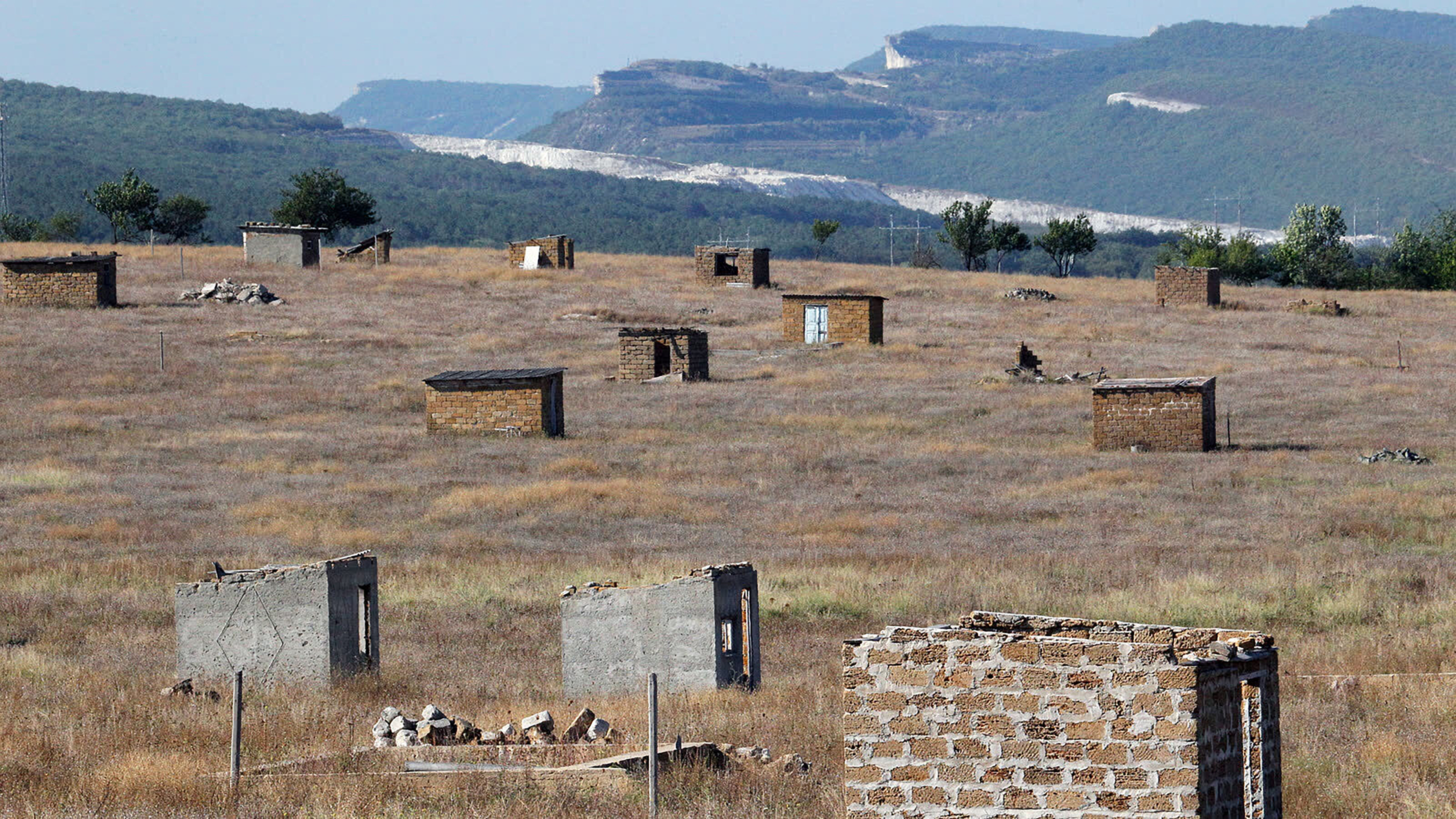
Then, in 2003, the government adopted a new criminal code that introduced severe penalties for squatting on Crimean land.37 At the same time, the authorities intensified anti-Crimean rhetoric, fueling ethnic tensions. Violence followed. Pogroms, raids, and police-led demolitions of Crimeans’ settlements increased. In one case, Crimeans were beaten “with extraordinary cruelty” by hundreds of soldiers, militiamen, and drunken mobs.38 Elsewhere, armed forces were called in to crush squatter camps, as happened in Tykha Bukhta in 2005, when 2,000 troops surrounded an encampment under the pretense of “maintaining order.”39
In response to both the legal repression and rising violence, the occupying groups named their acts protest fields and, in stubborn refusal to give ground, continued squatting. As the practice’s language transformed, so did its physical articulation. It was at this time that the practice shifted from physically inhabiting the lands to building structures as signifiers of the Crimeans’ land claims. The strategy took its final, familiar form: in a striking inversion, bodies without shelter became shelters without bodies. By 2007, 40,000 hectares of land were occupied by protest fields.
The Field
Let’s zoom in to the field itself:
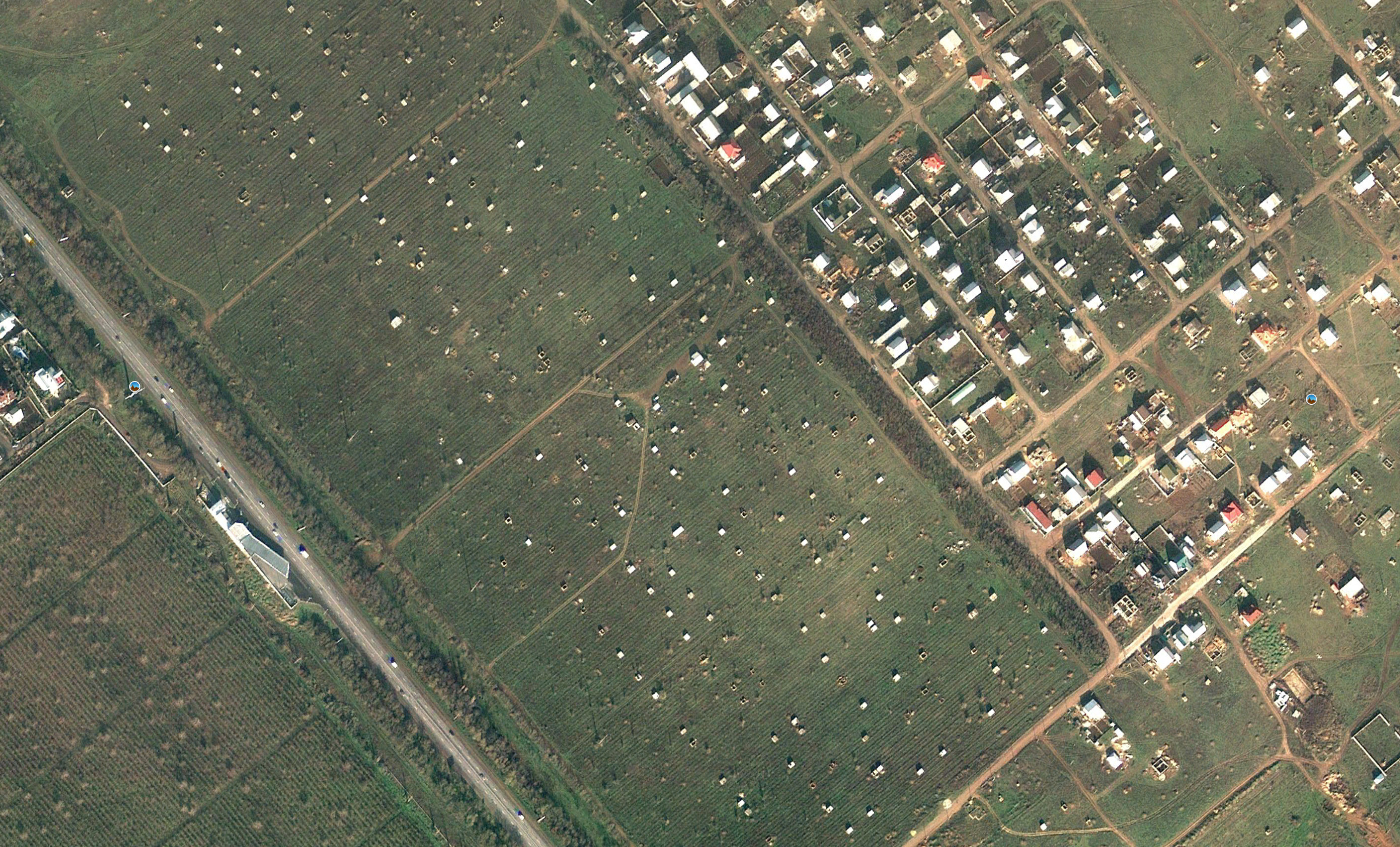
In this aerial view, we can recognize the protest field as an act of filling in, a logical continuation of the surrounding authorized residential parcels. The field is a pursuit of inclusion into the existing (sub)urban and social fabric of space claimed within it. The theorist and anthropologist Arjun Appadurai speaks of housing as what separates—following Giorgio Agamben—“bare citizenship” from the more stable political and social citizenships: housing as a prerequisite for sociality and inclusion in a legible social map.40 The protest field plots out the very possibilities of such sociality, entering the realm of the political from the edges, from the margins of the master plan. It’s an “architecture without architects”—though, for now, also without residents. It’s top-down planning from below.
How does a protest field take shape? It begins through a mix of grassroots mobilization, preexisting informal activist networks, and community or family ties. Organizers choose sites based on proximity to existing Crimean communities, accessibility, and the potential for eventual recognition by authorities. Some fields are placed near cities or infrastructure hubs to strengthen claims for inclusion in formal urban plans. Others emerge in more peripheral zones, staking a presence in contested or marginal spaces. Once a site is chosen, the collective moves to mark out plots, each participant claiming a space within the grid. Each participant then builds a hut on their plot: a claim, a demand, an opening move in a long bureaucratic game. The builder submits a formal appeal for land allocation to local authorities. The process often stretches over several years, its outcome contingent on constantly shifting political and economic tides. In the meantime, the hut serves as a placeholder, a stand-in for a property claim. Some may take a risk and begin constructing more permanent structures before official approval comes through. In such cases, the hut can also function as a tool shed, workshop, or storage space for construction. Neighboring hut-builders collaborate to create makeshift infrastructure—roads, sewage systems, water, and electricity—sometimes in tacit negotiation with local authorities and service providers. In either case, the huts, and the associated larger structures, remain at risk of demolition by local authorities, and are often sites of clashes with the police or vigilante gangs. Thus, the fields are always zones of precarity and liminality—their legal status always indeterminate, their structures neither fully recognized nor entirely erased—caught in an anticipation of completion or destruction.
This practice resonates with informal settlements across the globe. From the favelas throughout Brazil, to the pueblos jovenes on the outskirts of Lima, Peru, to climate- and war-induced refugee camps proliferating globally, the fields are likewise built and operated on the edge of legal authority. But informal settlements, built in and against emergency, result in a diversity of spatial configurations and building materials; structures are heterogeneous and dynamic, ad hoc and in flux. In stark contrast, the informal here is rigorously formalized. The protest fields are strictly ordered spaces, displaying a striking uniformity of material, size, and configuration. Their adherence to the grid is more akin to a professional housing development.
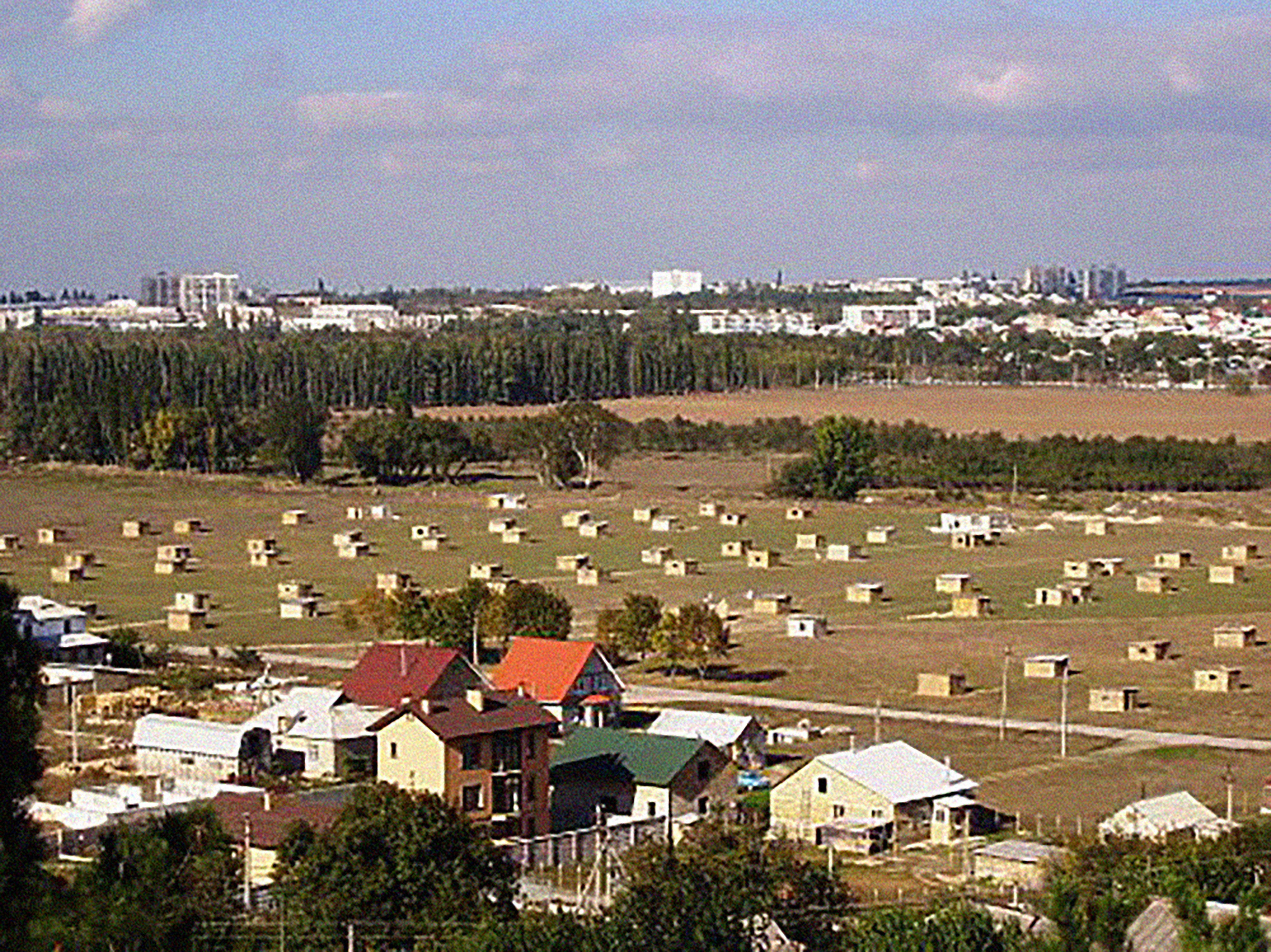
This spatial precision is strategic. The grid is not just a means of organizing space but a tool for asserting legitimacy. For theorist and historian Achille Mbembe, “Belonging is not an exclusively territorial matter. It is, in many ways, a matter of acceptance and recognition.”41 The protest field grid maps out where belonging should be; it sets the stage, utilizing the vocabulary of state-sanctioned development to render itself legible. Appropriating the grid as template, the protest field asserts itself within space that is typically allocated through regulated development.
This is not simply an appeal for inclusion within the existing order, or for acknowledgment as part of the social whole. It is not merely about contesting the system’s authority to exclude in the first place. Beyond hacking into the social and civic grid, it is an act of self-determination, an assertion of presence that does not wait for acknowledgment but materializes its own legitimacy. It does not just say We are here, it says We belong here and we will shape this space on our own terms. It’s not just about seizing land but seizing the tools and ability to inscribe a new set of social and spatial relations in the ground. In marking out the fields, in building up the huts, in replicating the grid, it is simultaneously a demand for inclusion and its fulfillment.
Let’s zoom in further: Consider this Google Earth sequence of a protest field at 44°58'21"N 34°04'35"E.
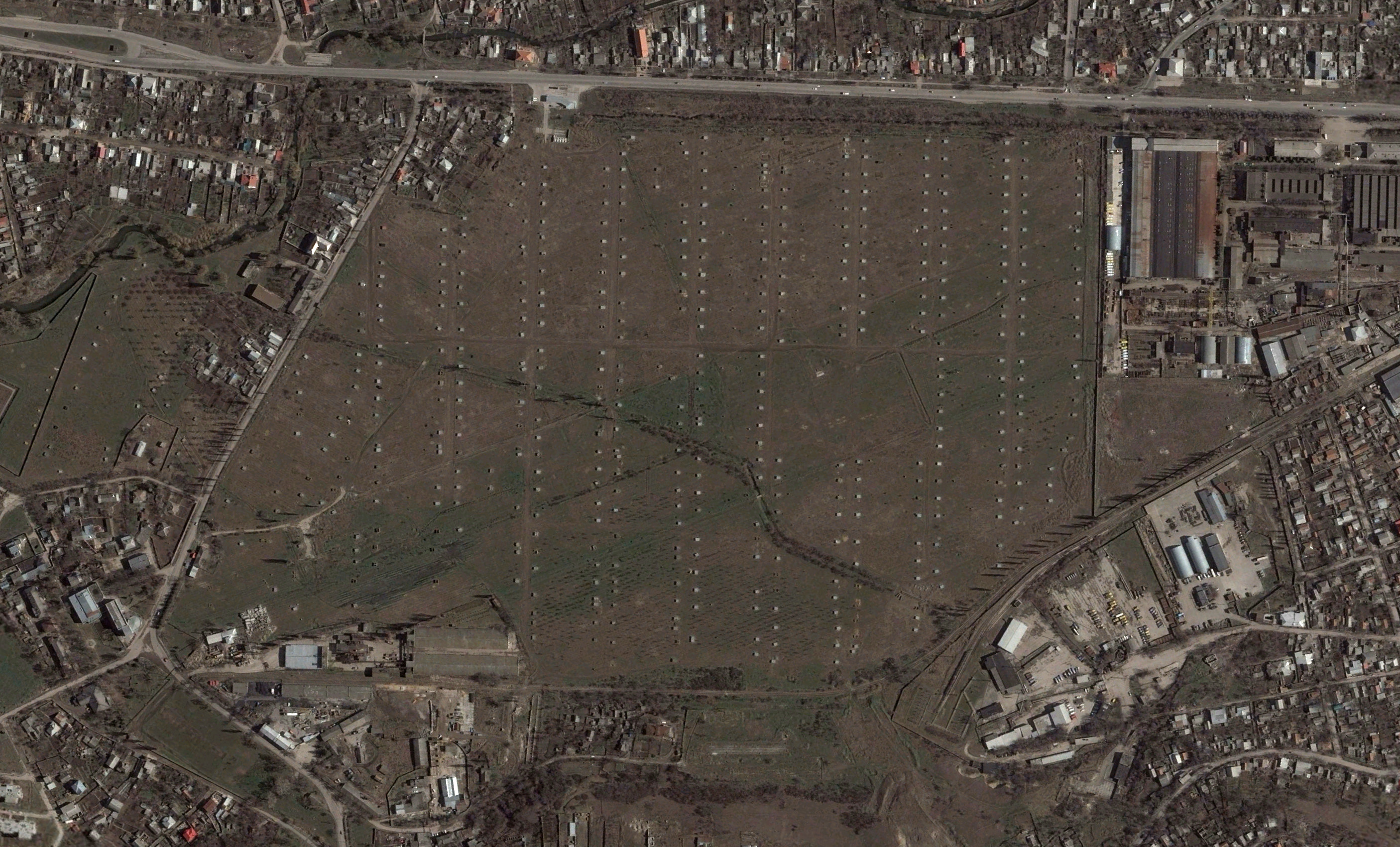
The year is 2007: The first traces of the protest field appear in March. Local news outlets report approximately 320 individual parcels, each containing a hut.42 By 2009, we see the foundations of more full-fledged structures. Through 2014, the houses are built up gradually at varying speeds: some remain huts, others become skeletal frames, and some push toward completion. A few roads emerge.
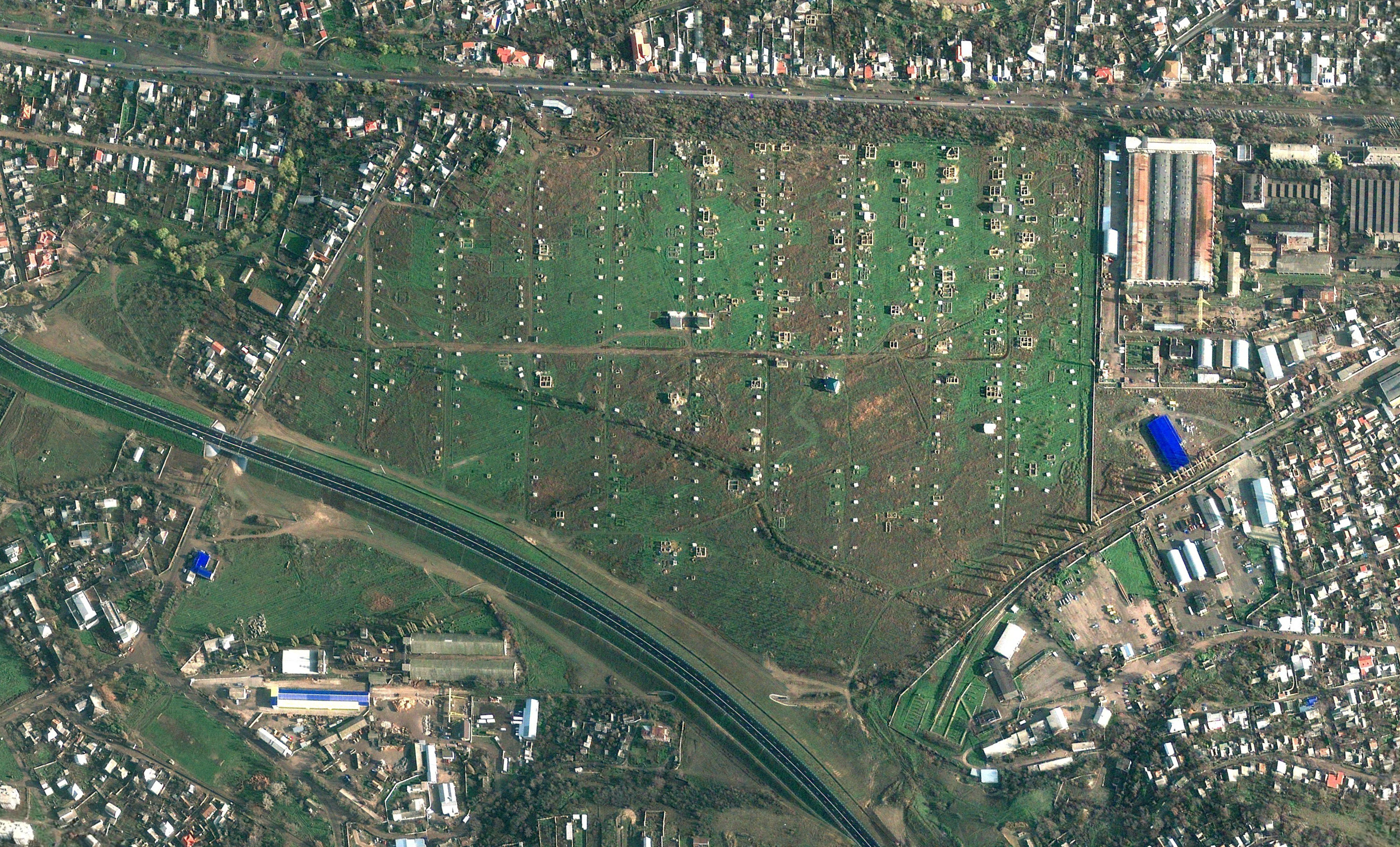
The year is 2014: The Russian Federation annexes Ukraine, launching what would later unfold into conflict twelve years long and counting, with a full-scale war now in its fourth year. Unlike the 1783 annexation under Catherine II, Vladimir Putin’s takeover requires no physical exile: Crimean Tatars remain; the ground beneath them is simply absorbed into a new territorial order. Crimean Tatar activist and journalist Sevil Aledinova, a formerly active participant in the fields, puts it simply, “Our homeland was stolen once again.”43 Over 2014 and 2015, construction on the protest field slows. A few more roofs appear, some frames expand, but much remains unchanged.
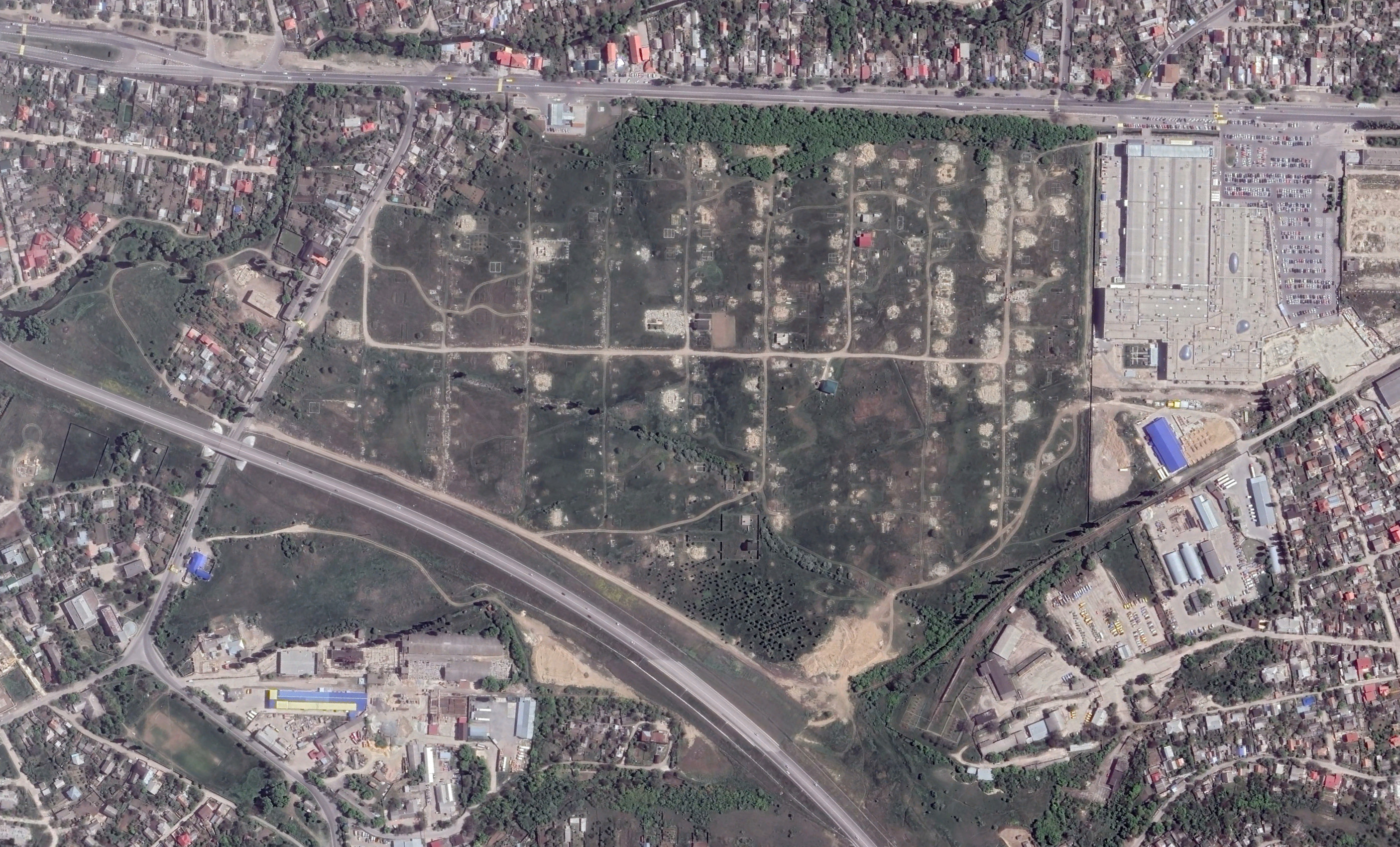
The year is 2016: In March, the view is of the field completely leveled, all but two houses demolished. Moving forward, we see the contours of an apartment complex, developed by a Russian real estate company, Vladograd. A polished fly-through video of a digital rendering shows an enclave of generic apartment buildings. The protest field pattern is replaced by another, this one a state-sanctioned, well-rehearsed copy-and-paste. The company’s website boasts of private security, video surveillance, and concierge services; there will be 10,000 apartments, 5,500 parking spaces, a school, a bank, a beauty salon, soccer fields, basketball courts, and landscaped boulevards.44 You wanted a grid? This is how it’s done.
These structures too stand largely empty. Vladograd’s website landing page advertises mortgage incentives for Russian military personnel, seeking settlers willing to relocate to Crimea. The architect and theorist Eyal Weizman speaks of the ways “conflicting geopolitical forces continuously interact with the surface of the earth as they slow into form.”45 Here, the protest field is the site where we see geopolitical conflicts played out. The protest field is now a battlefield: a proxy home in a proxy war. While the protest field practice was highly contested under the Ukrainian government, Russian authorities have taken easily to demolition. Fields are leveled, huts are crushed, their builders imprisoned or disappeared. “Today, there is little trace left of the protest fields,” Aledinova says. “Years of effort and hope, bulldozed before our eyes.”46 One vision of Crimea is overwritten with another.
Yet even as the protest fields are erased and absorbed into the Russian settlement infrastructure, their significance remains. In a landscape shaped by successive waves of annexation and forced displacement, where identities and sovereignties have been imposed and revoked with dizzying speed, these fields offered something rare: a self-determined, material assertion of belonging. The land Russia now occupies is already layered with micro-occupations, countersettlements, sites of resistance and persistence—expressions of a centuries-long struggle that stretches through nineteenth-century Russian imperialism, twentieth-century Soviet rule, and twenty-first-century neocolonialism. In “War by Any Other Name,” Anna Engelhardt asks, “What hope can one find today if Russia has annexed the Crimean Peninsula at least four times? What is it, there in those four attempts at total elimination of Indigenous Crimean Tatars, with the first one dating to 1783 and the last one ongoing since 2014?”47 Her answer lies in the sheer recurrence of these acts, in the centuries of displacement and repression that expose Russia’s inability to fully suppress decolonial resistance.
Coda: The Hut
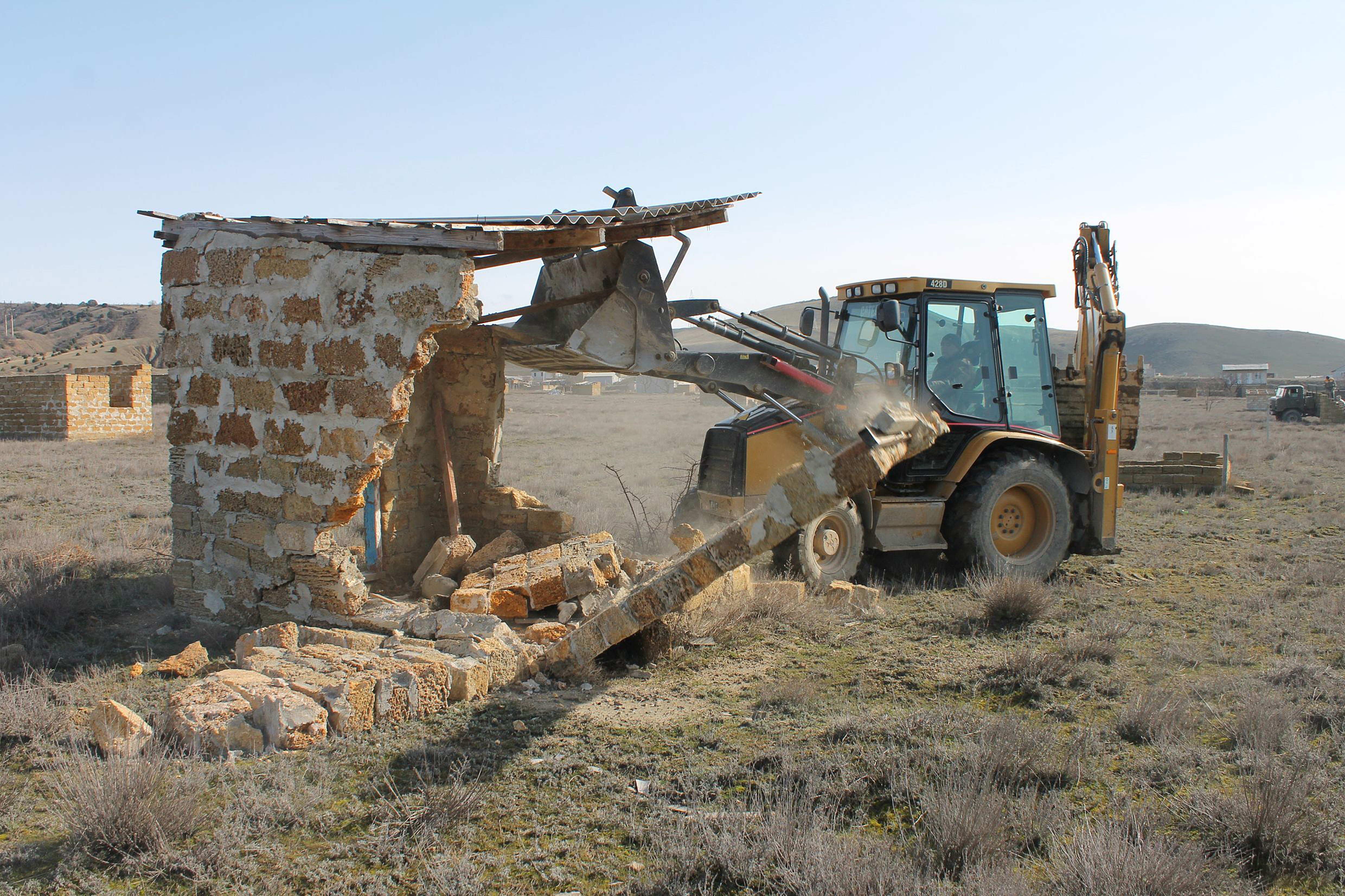
The hut is a provisional, liminal thing. As a house, the hut is both absurd and rather convincing. Like a kid’s crayon drawing, it’s the idea of a home: its potentiality.
While its status is shaky, its material properties are decidedly substantial. Its size ranges from one to four meters in width and two to three meters in height, depending on availability of materials and funds. Its roof is cheap corrugated metal. It may or may not have a foundation. The main structure is built from locally sourced limestone blocks. Notably, mortar is not always used: some huts are built up simply by stacking the blocks, further underscoring their unstable, placeholder quality.
Let’s pause here for a moment. Limestone, CaCO₃, rakushechnik, is a porous sedimentary rock composed primarily of calcite, formed from organic debris in shallow seas. Accumulating on the Black Sea bottom for an average of 550 million years, shell, coral, algal, fecal, and other organic deposits turned into solid stone. Crimea is rich in large deposits of exposed limestone whose abundance, easy extraction, and low transportation cost make it the cheapest available building material.48 In the construction of the protest hut, the material is extracted directly from the local landscape and (re)used or (re)inserted as part of the built landscape. The stuff—the substance of the land—becomes the very medium for reclaiming it. The act of building the hut becomes a literal grounding. Composed of life forms much older than the human species and our peculiar, human capacity to reorganize matter, the hut calls to a power of a different kind. On the one hand, this renders our territorial disputes and the lines we draw in the sand rather silly. On the other, the hut becomes a bond between a people’s situated history and the primacy of ground, somewhere between the micro scale of the calcite molecule and the macro scale of geological time. It is simultaneously molecular and planetary. “In the pores of those vast dramas of class and party, nation and history… it’s a question of being able to perceive both molar drama and molecular gesture together.”49
The land called Crimea has been caught in a swirl of state-building, imperial collapse, and spheres of influence that few places can match in frequency and intensity.50 While governments redraw borders and rename territories, the protest fields and the people who built them reassert a different kind of belonging. Here, we come back to the double bond of soil and blood. For a Crimean Tatar, whose historical experience has been structured by displacement and dispossession, this physical re-entrenchment into the land is crucial. This anchorage, in all its tenderness and urgency, is most visible today. Despite countless attempts to persuade my grandparents to emigrate, both following the 2014 annexation and through the violent unfolding of full-scale war in Ukraine, they refuse. They live in a small limestone house, nestled beside a larger one where their son and his family reside. They grow vegetables in their garden and in a greenhouse my grandfather built many years ago. A canopy of grapevines provides much-needed shade just outside the door, where a hand-built table and benches offer a place for daily gatherings over Turkish coffee. A different shade of green spreads across the ground. Take a moment, and you’ll see small watermelons tucked into their sprawling vines, seemingly scattered about but anchored, tethered to their tendrils. Maybe one is ripe enough to eat this evening. My grandparents will savor it, knowing it grew from the same soil they call home.
-
Marc-Antoine Laugier, Essai sur l’Architecture (Paris: Chez Duchesne, 1753). The primitive hut holds its place in architectural theory as a highly influential archetype and concept of the Enlightenment, later resurfacing within modernist architecture and planning. Theorized as the origin and prototype of all built enclosures, the primitive hut was valorized as a universal element of humanity to advocate for a return to simplicity and rational structural design. The notion of the “primitive” and the primitive hut prototype have been widely critiqued and countered, by questioning the implications of a pursuit of origin, simple nature, and elementary or universal forms within the dominant architectural discourse in the West. ↩
-
Sitora Rooz, E. Vincent, and Svitlana Matviyenko, “Technologies of Russian Colonialism: Occupation, Persistence, Implication,” The Funambulist, no. 55 (August 2024), link. To date, this genocide is officially recognized as such by Ukraine, Latvia, Lithuania, and Canada. ↩
-
Anton Bebler, “Crimea and the Ukrainian-Russian Conflict,” in “Frozen Conflicts” in Europe, ed. Anton Bebler (Leverkusen: Verlag Barbara Budrich, 2015), 189–208. ↩
-
Crimean Tatar (qırımtatarlar) and Crimean (qırımlar) are used interchangeably throughout the essay. ↩
-
Many of whom were themselves forcibly relocated to Crimea under Stalin. ↩
-
“Russia needs its paradise,” Prince Grigory Potemkin, Catherine II’s general and lover, wrote in 1783, urging annexation. See Marc Santora, “More Than a Sun-Splashed Resort, Crimea Holds a Key Place in Russia’s War Effort,” New York Times, August 16, 2022. ↩
-
Ukraine is known for its exceptionally fertile soil, called Black Soil or chernozem in Ukrainian. High in organic matter and nutrients, chernozem has long underpinned the region’s agricultural productivity and shaped its geopolitics and economics. ↩
-
Bebler, “Crimea and the Ukrainian-Russian Conflict.” ↩
-
Idil P. Izmirli, “Return to the Golden Cradle: Postreturn Dynamics and Resettlement Angst Among the Crimean Tatars,” in Migration, Homeland, and Belonging in Eurasia, ed. Synthia J. Buckley and Blair A. Ruble (Washington, DC: Woodrow Wilson Center Press with Johns Hopkins University Press, 2008), 227–264. ↩
-
“Potemkin’s desire to settle the land entrusted to him of Novorossiia with immigrants from other countries became a symbol of the future unity of the peoples of the Russian Empire’s new provinces.” Andrei Zorin, “Eden in Taurus: The ‘Crimean Myth’ in Russian Culture of the 1780s–90s,” in By Fables Alone: Literature and State Ideology in Late Eighteenth–Early Nineteenth-Century Russia, trans. Marcus C. Levitt (Boston: Academic Studies Press, 2014), 104. ↩
-
For more on this topic, see Willard Sunderland, “Imperial Space: Territorial Thought and Practice in the Eighteenth Century,” in Russian Empire: Space, People, Power, 1700–1930, ed. Jane Burbank, Mark von Hagen, and Anatolyi Remnev (Bloomington: Indiana University Press, 2007), 33–66. ↩
-
Brian G. Williams, “A Community Reimagined: The Role of ‘Homeland’ in the Forging of National Identity: The Case of the Crimean Tatars,” Journal of Muslim Minority Affairs 17, no. 2 (1997): 225–252. ↩
-
“The use of the word watan (Turkish vatan) in a political sense, equivalent to the French patrie… dates from the late eighteenth century, and is clearly due to European influence and example.” Bernard Lewis, “Watan,” Journal of Contemporary History 26, no. 3/4 (1991): 523–533. ↩
-
Achille Mbembe, Brutalism (Durham, NC: Duke University Press, 2024), 116. ↩
-
Serhy Yekelchyk, “The Crimean Exception: Modern Politics as Hostage of the Imperial Past,” Soviet and Post-Soviet Review 46, no. 3 (2019): 308. ↩
-
Hakan Kırımlı, “The ‘Young Tatar’ Movement in the Crimea, 1905–1909,” Cahiers du monde russe et soviétique 34, no. 4 (1993): 553. ↩
-
Kırımlı, “The ‘Young Tatar’ Movement,” 537. ↩
-
Kırımlı, “The ‘Young Tatar’ Movement,” 549. ↩
-
Yekelchyk, “The Crimean Exception.” ↩
-
Williams, “A Community Reimagined.” ↩
-
Yekelchyk, “The Crimean Exception,” 311. ↩
-
Rooz, Vincent, and Matviyenko, “Technologies of Russian Colonialism.” ↩
-
Neil MacFarquhar, “For Crimea, It’s Russian Troops In, Tourists Out,” New York Times, May 25, 2014. ↩
-
Bebler, “Crimea and the Ukrainian-Russian Conflict,” 189–208. ↩
-
They were assigned the designation of “special settler,” which confined their movement to small delineated areas and severely limited access to employment and social services. ↩
-
Mustafa Dzhemilev, interview by Mykola Veresen, The Oral History of Independent Ukraine 1988–1991, June 14, 1996, video, 36:10. ↩
-
Yekelchyk describes them as “one of the strongest and best-organized dissident movements in the late Soviet Union.” Yekelchyk, “The Crimean Exception,” 313. ↩
-
Michael Ignatieff, Blood and Belonging: Journeys into the New Nationalism (New York: Farrar, Straus and Giroux, 1994). ↩
-
As noted by Dzhemilev, it was at this time that “the term ‘Crimean Tatars’ appeared in the Soviet press for the first time. Before that, the existence of this issue was completely denied, and the phrase ‘Crimean Tatars’ was essentially considered forbidden. The Soviet regime had followed a policy of referring to Crimeans as ‘Tatars formerly residing in Crimea.’” F. T. Aydin and F. K. Sahin, “The Politics of Recognition of Crimean Tatar Collective Rights in the Post-Soviet Period: With Special Attention to the Russian Annexation of Crimea,” Communist and Post-Communist Studies 52, no. 1 (2019): 39–50. ↩
-
The Ukrainian Citizenship Law of 1991, along with its 1997 amendment, prevented many Crimean Tatars from obtaining citizenship. As noncitizens, they were ineligible for employment, housing, and essential services. See Izmirli, “Return to the Golden Cradle,” and Dzhemilev, interview by Veresen. ↩
-
Tetyana Malyarenko and David J. Galbreath, “Crimea: Competing Self-Determination Movements and the Politics at the Centre,” Europe-Asia Studies 65, no. 5 (2013): 912–928. ↩
-
Dzhemilev, interview by Veresen. ↩
-
Kateryna Iakovlenko, “Flavors of Freedom: Rethinking the Late 1980s and Early 1990s,” Reconstruction, e-flux Architecture (September 2023), link. Dzhemilev: “This led to major clashes with the authorities, sometimes even bloody ones, especially on the southern coast.” ↩
-
Sevil Aledinova, interview with author, November 17, 2024. ↩
-
Aledinova, interview with author, November 17, 2024. ↩
-
Izmirli, “Return to the Golden Cradle.” ↩
-
“The new code detailed punishments—including fines, two years of forced work, and imprisonment—for squatting on land in Crimea… Special amendments to the Ukrainian Law on Militia authorized the use of dogs, chemicals, and special arms for the purpose of ‘preventing’ or ‘liquidating’ mass squatting.” Izmirli, “Return to the Golden Cradle,” 246. ↩
-
Degirmenkoy village, December 1989. See Gulnara Bekirova, Pol veka soprotivleniya: Krymskie tatary ot izgnaniya do vozvrashcheniya (1941–1991 gody). Ocherk politicheskoy istorii (Kritika, 2017). ↩
-
Izmirli, “Return to the Golden Cradle,” 249. ↩
-
See Arjun Appadurai, “Housing and Hope,” in The Future as Cultural Fact: Essays on the Global Condition (New York: Verso, 2013), 115–130. Appadurai defines political citizenship as that “which allows for claims on parties, municipalities, war bosses, city bureaucracies, banking institutions, and the police,” and social citizenship as that “which involves the transactions of debt, consumption, marriage, work-related information, and social standing in a community or neighborhood” (122). ↩
-
Mbembe, Brutalism, 112. ↩
-
“Pod Simferopolem samozakhvatchiki ukhodyat s polyan protesta,” Kia News, November 12, 2013, link. ↩
-
Sevil Aledinova, interview with author, November 17, 2024. ↩
-
“… or accelerate in a blast!” Eyal Weizman, Forensis: The Architecture of Public Truth (Berlin: Sternberg, 2014), 15. ↩
-
Sevil Aledinova, interview with author, November 17, 2024. ↩
-
Anna Engelhardt, “War by Any Other Name: Patterns of Russian Colonialism,” The Funambulist, no. 42 (July 2022), link. ↩
-
Other advantages are its relative lightness, porousness, and natural insulation properties. ↩
-
McKenzie Wark, Molecular Red: Theory for the Anthropocene (New York: Verso, 2016), xvi. ↩
-
Thank you to Elsa Mäki, in conversation with the author. ↩
Sanie Irsay is a Crimean Tatar artist based between New York and Amsterdam. She is centrally concerned with social and spatial structures, zones of inclusion, exclusion, and exception.
